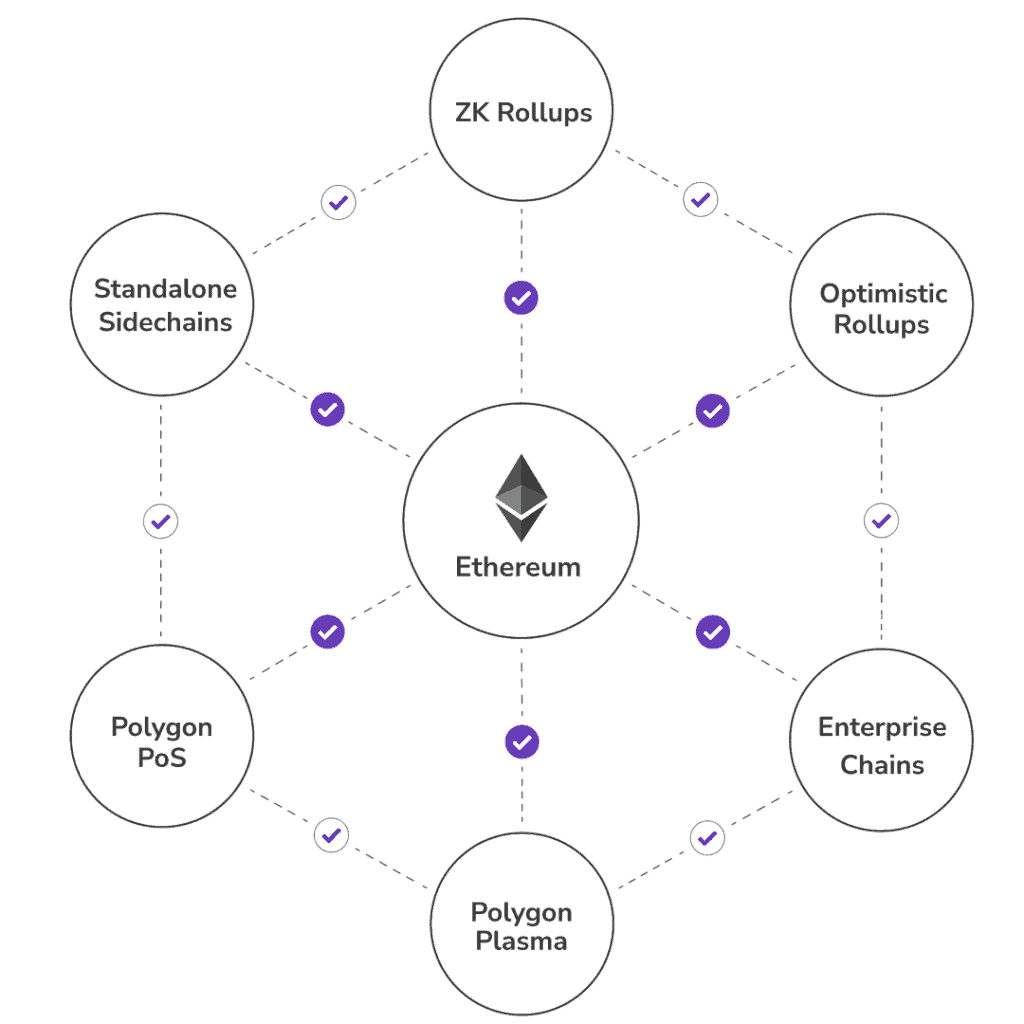As DeFi adoption grows, the number of active users is increasing by orders of magnitude, leading to overload on Ethereum (the most popular protocol for interacting with DApps). This has resulted in high transaction fees and long transaction times.
Multiple projects are trying to solve Ethereum’s scalability issue, one of these projects being Polygon. In this post, we will explain what Polygon is, what Polygon wants to achieve and how the protocol works.
What is Polygon (MATIC)? #
Formerly known as the Matic Network, Polygon is a framework for creating interconnections between blockchain networks. It attempts to address some of the issues that Ethereum is currently struggling with. These issues are scalability, high transaction fees, and slow transactions. Polygon tries to solve this by using a new sidechain solution.
Rather than just using a common layer 2 scaling solution like its predecessor Matic Network (which used a technology known as Plasma to process off-chain transactions before finalizing them on the Ethereum main chain), Polygon is designed to be a complete platform. It is also designed to launch blockchains without restrictions.
Polygon allows developers to launch predefined blockchain networks with attributes tailored to their needs. These can be further customized with a growing number of modules, allowing developers to create sovereign blockchains with more specific functionality.
Polygon’s Goal #
Polygon’s main goal is to enable an open network in which users can easily use various decentralized products and services without the need for an intermediary. Polygon wants to create a hub that other blockchains can interact with, and by doing so, overcome their shortcomings such as limited scalability, high transaction fees or security.
Polygon utilizes a variety of layer 2 solutions to realize their vision, including:
- Plasma Chains: Plasma Chains: Plasma chains are used to move crypto-assets through plasma bridges between the main chain and the sidechains.
- POS Chain: Polygon’s main chain is a sidechain pegged to the Ethereum main chain. This chain is known as the POS Chain and adds a Proof of Stake (POS) layer of security to blockchains launched on Polygon.
- ZK Rollups: Zero Knowledge Rollups (ZK Rollups) is a layer 2 solution that collects a large number of off-chain transactions and transfers them into a single transaction, reducing the transaction fees and increasing the transaction speed.
- Optimistic Rollups: A layer 2 solution that was developed by Optimism. Optimistic Rollups work on top of the Ethereum main chain to enable near-instantaneous transactions through the use of Proof of Fraud.
 Planned scaling solutions on Polygon
Planned scaling solutions on PolygonBy implementing multiple layer 2 scaling solutions, Polygon can keep the network’s transaction fees very low. Because Polygon opted for a multiple-solution approach to the scaling problem, Polygon covers itself in case one of the scaling solutions does not work as intended.
How Polygon works #
Polygon’s architecture is best defined as a system consisting of four different layers:
• Ethereum layer
• Security layer
• Polygon network layer
• Execution layer
The Ethereum layer essentially consists of smart contracts that are implemented on the Ethereum network. These smart contracts manage transaction finality, staking and communication between Ethereum and the Polygon blockchain. The security layer works together with Ethereum and offers a “validators as a service” role that gives blockchains an extra layer of security. The use of both the Ethereum and Security layers are optional, meaning they don’t always need to be used. However, to ensure the best performance and security, it is advised to use all layers.
Beyond the Ethereum and Security layers, two layers are mandatory to use. The first is the Polygon network layer, which is the ecosystem of blockchain networks that makes up Polygon. Each has its own community and is responsible for managing the local consensus and block production. The second is the execution layer, which is Polygon’s implementation of the Ethereum Virtual Machine (EVM) used to execute smart contracts.
Blockchains that are running on Polygon can communicate with each other and with the Ethereum main chain through Polygon’s messaging capabilities. This will create a variety of new use cases, such as making decentralized applications (dApps) more efficient and allowing smooth value exchange between different platforms.
However, please note that at the time of writing only the Proof of Stake blockchain and Plasma scaling solution are up and running. Developers are not yet able to launch their own standalone or shared security chains on Polygon until these features are released. Likewise, neither ZK nor optimistic rollups have been launched on the network. Plasma is currently the only layer 2 scaling solution available on Polygon. We have to wait for what the future of Polygon will bring us.